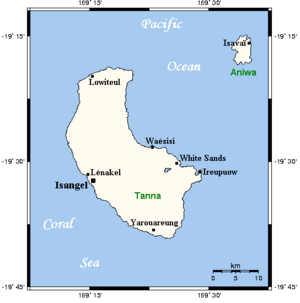Tanna ground dove facts for kids
The Tanna ground dove (Pampusana ferruginea) was a type of dove that is now extinct. This means it no longer exists anywhere in the world. It was also known as Forster's dove of Tanna. This special bird lived only on the Pacific island of Tanna in Vanuatu. People on Tanna called it mahk. Scientists believe its closest relative might be the Santa Cruz ground dove.
Quick facts for kids Tanna ground dove |
|
|---|---|
 |
|
| Female painted in 1774 | |
| Conservation status | |
| Scientific classification | |
| Genus: |
Pampusana
|
| Species: |
ferruginea
|
 |
|
| The female specimen was shot in the forest at Port Resolution, which is the bay west of Ireupuow. | |
| Synonyms | |
|
|
About Its Name
Scientists group living things to understand them better. This is called taxonomy. The Tanna ground dove's scientific name is Pampusana ferruginea.
The first person to describe this bird was Johann Reinhold Forster in 1775. Later, in 1829, Johann Georg Wagler also wrote about it. The bird was first placed in a group called Gallicolumba. This group includes other ground doves.
Its genus name was changed in 2019. It used to be Alopecoenas, but now it is Pampusana. This change happened because Pampusana was an older name that had priority.
What It Looked Like
We only know about the Tanna ground dove from two birds. Both of these birds are now lost. The most famous one was a female. Georg Forster drew a picture of her in August 1774. This was during James Cook's second trip around the world.
The drawing of the female bird is now at the Natural History Museum in London. We do not know what happened to the actual bird. Another bird, a male, was also part of a collection in London. Only a picture of this male bird exists today.
According to Forster's notes, the female bird was about 27 centimeters (10.6 inches) long. Her head and chest were a rusty brown color. Her back was dark red to purple. The wings had a dark green color. The tips of her wing feathers were brown-grey with light edges. Her belly was grey.
The male bird looked different. His forehead, eyebrows, and the lower part of his head were white. His throat and chest were also white. His belly was reddish-black. The bird's beak was blackish. Its eyes were yellowish, and its feet were red.
When the Forsters studied the female dove, they found a wild nutmeg in its stomach. They tried to find the nutmeg tree on Tanna but could not. Later, people found out the tree was common on the island. It was just small and easy to miss. Local people called the tree netan.
Why It Disappeared
We do not know the exact year the Tanna ground dove became extinct. Scientists think it probably disappeared by the early 1800s.
On August 17, 1774, Johann Reinhold Forster and his son Georg saw the female bird. They shot it to study it. The only proof it existed, besides the paintings, is a note from Forster. He wrote that they shot "a dove of a new kind" in a forest.
We are not sure why this bird died out. However, many scientists believe that rats brought to the island by ships were the main reason. These rats would have eaten the birds' eggs and chicks.


